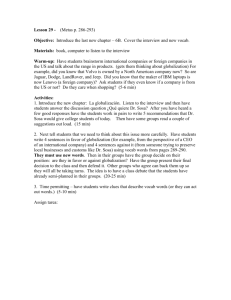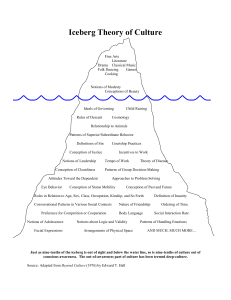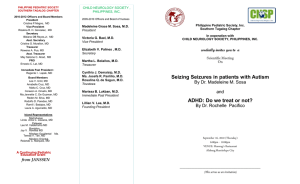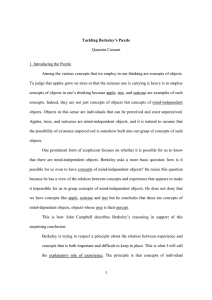REFERENCE AND SUBJECTIVITY
advertisement
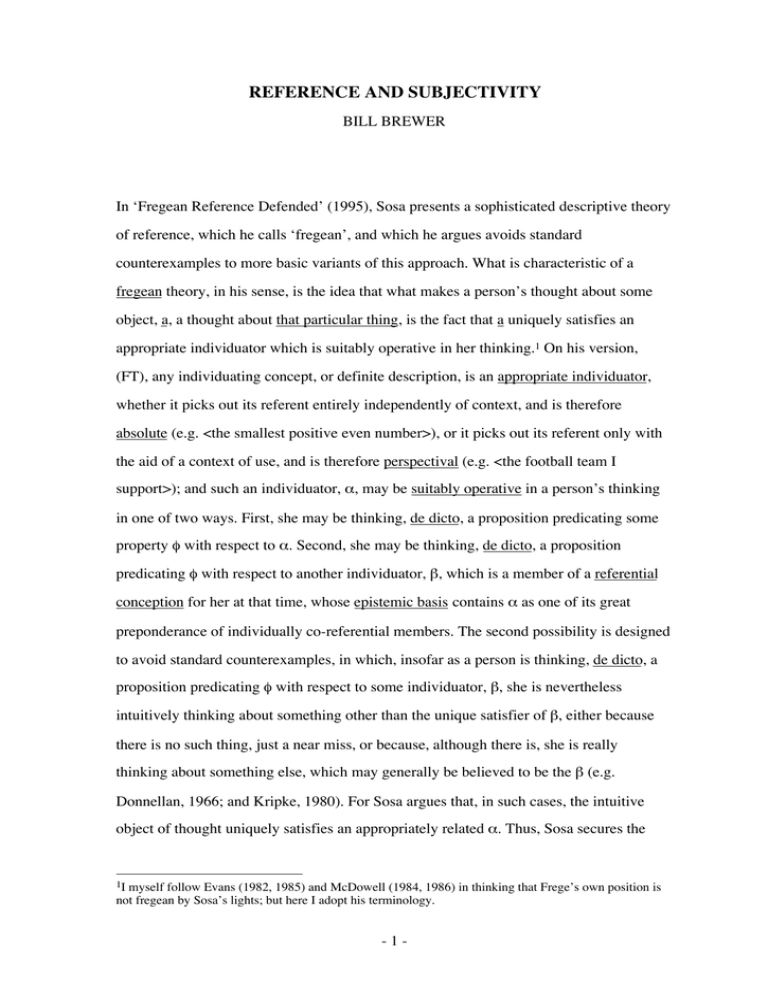
REFERENCE AND SUBJECTIVITY BILL BREWER In ‘Fregean Reference Defended’ (1995), Sosa presents a sophisticated descriptive theory of reference, which he calls ‘fregean’, and which he argues avoids standard counterexamples to more basic variants of this approach. What is characteristic of a fregean theory, in his sense, is the idea that what makes a person’s thought about some object, a, a thought about that particular thing, is the fact that a uniquely satisfies an appropriate individuator which is suitably operative in her thinking.1 On his version, (FT), any individuating concept, or definite description, is an appropriate individuator, whether it picks out its referent entirely independently of context, and is therefore absolute (e.g. <the smallest positive even number>), or it picks out its referent only with the aid of a context of use, and is therefore perspectival (e.g. <the football team I support>); and such an individuator, α, may be suitably operative in a person’s thinking in one of two ways. First, she may be thinking, de dicto, a proposition predicating some property φ with respect to α. Second, she may be thinking, de dicto, a proposition predicating φ with respect to another individuator, β, which is a member of a referential conception for her at that time, whose epistemic basis contains α as one of its great preponderance of individually co-referential members. The second possibility is designed to avoid standard counterexamples, in which, insofar as a person is thinking, de dicto, a proposition predicating φ with respect to some individuator, β, she is nevertheless intuitively thinking about something other than the unique satisfier of β, either because there is no such thing, just a near miss, or because, although there is, she is really thinking about something else, which may generally be believed to be the β (e.g. Donnellan, 1966; and Kripke, 1980). For Sosa argues that, in such cases, the intuitive object of thought uniquely satisfies an appropriately related α. Thus, Sosa secures the 1I myself follow Evans (1982, 1985) and McDowell (1984, 1986) in thinking that Frege’s own position is not fregean by Sosa’s lights; but here I adopt his terminology. -1- right results by appeal only to the relation of unique satisfaction between a and some individuator, rather than offering an alternative relation between a and β itself, combining a degree of satisfaction with additional causal components.2 So he remains faithful to the official fregean rubric. What is so desirable about this rubric, though? Suppose α is <the A>. The truthconditions of the subject’s thought therefore have the following form. ∃x∀y[[Ay ↔ x=y] & φx] α is suitably operative in the subject’s thinking in one of the two ways given above. Hence A is subjectively accessible to her: it is entirely determined, in one of these two ways, by how things are for the subject, by what is available within her subjective perspective. Assume that φ is likewise subjectively accessible. (FT) therefore has the consequence that the truth-conditions of a person’s thought about some object, a, are entirely determined by how things are subjectively for her. That is, it meets the condition which I call the subjective determination of truth-conditions, (SDTC). I believe that this plays a key role in Sosa’s motivation for (FT), for two reasons. First, the ‘competing doctrine’, with which he explicitly contrasts (FT), fails to meet (SDTC). Second, (SDTC) has strong intuitive support of its own. I take these in turn. Sosa characterizes the ‘competing doctrine’ as follows. (N) A genuine relation of reference must be constituted by some special relation binding the thinker with the object of reference, probably some causal psychological relation like perception or memory. 2See Blackburn’s (1984, ch. 9, sect. 7) discussion of the ‘Right Relation’, for a move in this direction. Sosa cites Boër and Lycan (1986) for insistence upon the importance of extrinsic causal requirements. -2- The key contrast with (FT) is that (N) introduces additional causal determinants of the truth-conditions of a person’s thoughts, over and above anything which is determined by her subjective condition. Against this, Sosa insists that any such causal conditions upon reference enter only “in a derivative, or ‘by the way’ fashion”, as necessary conditions upon an object’s unique satisfaction of subjectively accessible individuators, like <the man I see drinking a clear liquid>, or <the person I saw drinking just now>. His opposition to (N) therefore indicates an endorsement of (SDTC). Furthermore, (SDTC) has powerful independent appeal, along the following lines. It is a necessary condition upon a person’s having a thought about an object, a, that she grasps its content. That is, she must have some conception of what it would be for it to be true. Any such conception, of hers, though, of what it would be for that thought to be true, draws only upon how things are subjectively for her. Suppose that (SDTC) is not met: truth-conditions are determined in part by causal factors external to the thinker’s subjective perspective. Then, although a person, S, is actually thinking the thought, T 1 , with truth-conditions TC1 , things might have been just as they are for her subjectively, had she instead been thinking the distinct thought, T2 , with truth-conditions TC2 , where the difference between her actually thinking T1 and counterfactually thinking T2 are accounted for entirely by the extra-subjective, causal, determinants of truth-conditions. Thus, S thinks T 1 . So she must have some grasp of what it would be for its truthconditions, TC1 , to obtain. This draws only upon how things are subjectively for her. Hence it is identical to the conception which she would have had of what it is for TC2 to obtain had she been thinking T2 instead. For, recall, the only difference between her actual T1 -thinking and her counterfactual T 2 -thinking is external to her subjective perspective. This conception of what it is for TC1 to obtain is supposed to constitute her grasp of the content of her thought. Yet we have just seen that it is entirely insensitive to the distinction between TC1 , and TC2 . Ascribing T1 to her, as opposed to T 2 , is therefore to make a distinction between thoughts which is more fine-grained than the subject’s own understanding of their contents. Hence it follows from the rejection of (SDTC) that a -3- person may think a thought without grasping its content, as distinct from that of some other. This is unacceptable. So (SDTC) stands. It is simply an expression of the pretheoretic requirement that which thought a person is thinking is determined by her understanding of its content. This intuitive motivation for (SDTC) may in the end be found wanting; but it does in my view justify Sosa’s strategy of exploiting the mechanism outlined above in defence of (SDTC) against the counterexamples offered in the literature in support of (N). 3 I am not going to take up the issue here of whether this mechanism is successful in every case. What I offer instead is a discussion of the fate of (FT) at the hands of a more general worry about the definitive fregean proposal that reference to spatiotemporal particulars is to be secured by their unique satisfaction of appropriate individuators. These individuators are either absolute or perspectival. The ‘aid’ of a context which is required in the latter case effectively embeds into a perspectival individuator a brute stipulation of the numerical identity of some object, place or time, in relation to which the target referent is to be identified. Correlatively, absolute individuators are purely qualitative: they pick out their referents, either directly, by their own qualitative features, or by their relations with other things, which are in turn picked out, either directly, by their own qualitative features, or by their relations with yet other things, which are likewise, ultimately, qualitatively identified.4 Particular spatiotemporal objects allow for a distinction between qualitative and numerical identity.5 For any such object, or system of related objects, that is, there is the possibility, at least in principle, of another, qualitatively identical object, or system, 3Putnam (1975) and Burge (1979) develop parallel objections to (SDTC) with respect to reference to kinds. 4I rule out without argument here appeal to heicceistic individual concepts, like ‘the thing that pegasizes’ (Quine, 1980). These are supposed to be neither purely qualitative, nor, unlike brute stipulation, are they object-dependent, in the sense that their significance requires the existence of a corresponding object. Yet it is a priori that they apply to no more than one thing. 5I also reject Leibnizian views, which hold to the identity of indiscernibles for persisting material objects. -4- which is nevertheless numerically distinct; and this is so however complex or extensive the system may be. To this corresponds the possibility, for any absolute individuator, α, that it may be multiply satisfied, and therefore that it fails to refer, since its mode of reference is supposed to be unique satisfaction. Call this the possibility of massive reduplication relative to α. Suppose that (FT) is correct, and that a person, S, is thinking about an object, a, in virtue of having individuator α suitably operative in her thinking; and suppose further that α is absolute. It follows that S only knows that she is referring to anything at all, never mind that she is actually referring to a, if she knows that the possibility of massive reduplication relative to α is not actual. This is something she can never know, though. For any reduplicated system may be indefinitely distant from her in both space and time. (FT) therefore has the consequence that a person can only know that she is succeeding in thinking about something if the relevant individuator operative in her thinking is perspectival (see Strawson, 1959, ch. 1, pt. I; and Brewer, 1999, ch. 2). I assume, I hope uncontroversially, first, that any theory of reference must acknowledge the existence of at least some cases in which the subject is in a position to know that she is successful, and, second, that it must treat such cases as more basic than those in which she is not in such a position. Thus, (FT) must regard reference in which a perspectival individuator is operative as both essential to the very possibility of reference to spatiotemporal objects, and as more basic than any case in which the operative individuator is supposed to be absolute. Perspectival individuators secure reference to particular objects by stipulating the numerical identity of some entity relative to which the target referent is identified. Call this the anchor of the individuator in question. An anchor may be supposed either to be a mind-dependent experiential item, or to be an element of the mind-independent world. The first alternative yields an account of singular reference along the lines proposed by Searle in Intentionality (1983, esp. ch. 2). The most basic reference to mind-independent objects proceeds by description embedding anchoring reference to some particular token -5- experience. Thus, [That (seen) F is φ] is rendered, roughly, as [The F appropriately causally responsible for this F-type visual experience is φ]. I consider this option in detail below. Perspectival individuators with a mind-independent anchor, on the other hand, automatically require a supplement to Sosa’s official fregean theory (FT), by some commitment to (N). For brute stipulation of the numerical identity of some such anchor, relative to which the target referent is to be identified, just is “a genuine relation of reference constituted by some special relation binding the thinker with the object of reference”. One might admit this supplement, but insist that the appeal to (N) need only be very limited. Perhaps the only non-fregean singular term required is the first person pronoun, ‘I’. There is some evidence that this is Sosa’s view. For the examples he gives of perspectival individuators are such expressions as <the person I saw drinking just now>, and <the one I seem to see drinking>. So, the suggestion is that the first person pronoun yields a unique mind-independent anchor. The remaining apparatus of singular reference operates by embedding this into perspectival individuators which therefore pick out their target referent in the world on the basis of some psychological relation, such as present or past perception, memory, or whatever, in which it stands to the subject. This certainly is a concession by the proponent of (FT) as a complete account of singular reference; but it seems to me also to have serious difficulties of its own. The current proposal simply presupposes a satisfactory account of reference to mindindependent particulars in perception and memory. For a given subject, S, and in favourable circumstances, C, it is taken for granted that there is a determinate answer to the question which object in the world is, say, the F which S is perceiving in C. So the question immediately arises how this singular reference is supposed to be secured. -6- Either a person’s subjective condition in perception uniquely determines which particular object she is perceiving, or it does not. If it does, then we have lost any real motivation, in this case at least, for the distinctively fregean idea that reference is secured by the unique satisfaction of an appropriately operative individuator. For we have the possibility of direct demonstrative reference to the object itself, exploiting its presence within the thinker’s subjective perspective. To say that this uniquely determines its numerical identity is just to say that she is subjectively acquainted with that thing, in such a way as to make possible her identification of it in thought without the aid of any descriptive individuator. This is precisely the line which I shall eventually be recommending; but it really is a radical alternative to (FT), and it is certainly not Sosa’s response at this point. He would say that a person’s subjective condition in perception does not uniquely determine which particular object she is perceiving. Then there seem to me to be just two options. Either the object of perception is fixed directly as that object (of the right kind) which happens to stand in the appropriate causal relation with the subject’s experience, or this causal condition itself shows up in an individuator suitably operative in the subject’s perceptual condition, which therefore fixes the object of perception by description, as the object standing in such a causal relation with this experience. The first option is really a version of (N). For it is the fact that the object in question stands in the causal psychological relation we call perception which is supposed to constitute the relation of perceptual reference. (SDTC) therefore fails at this most fundamental level.6 Yet (SDTC) is Sosa’s legitimate motivation for (FT) from the outset. On the second option, the perspectival individuator <the F I now see> is effectively shorthand for, or epistemically based upon, something like <the F appropriately causally responsible for this F-type 6It might be said that (SDTC) is met with respect to perceptually-based thoughts on this view. For such thoughts have truth-conditions of this form: ∃x∀y[[Ay ↔ x=y] & φx], with ‘Ax’ subjectively accessibly interpreted as ‘x is an F which I now see’. The difficulty is that this description does nothing to reveal the identity of whatever it may be that it picks out; and a fregean theory which is satisfied with meeting (SDTC) in this attenuated sense looses its intuitive advantage over (N), which (SDTC) is intended to capture. There is also a problem with the subject’s conception of what F ’s might be. See n. 8. -7- visual experience>. So we return to the Searlean account, on which perspectival individuators secure reference to mind-independent particulars by stipulating the numerical identity of a mind-dependent anchor. I think that this is Sosa’s only real option at this stage. Call the model individuator on this view - <the F appropriately causally responsible for this F-type visual experience> - α 0 . This is intended to provide the subject with his knowledge of which object he is thinking about, only given which does he genuinely understand the thought which he is supposed to be having about that particular F in the world around him. So we should ask precisely what conception α 0 provides of such a mind-independent thing. I shall argue that this is bound to be unsatisfactory. The crucial issue concerns the relation between reference to particular F’s, and reference to F-type experiences, as these occur in α 0 . I can see just two possibilities. First, the subject grasps what particular F’s are - the nature of such things, as individual mind-independent objects of a certain kind - independently of, and prior to, any capacity for the identification and categorization of F-type experiences, which he acquires only on the basis of the former understanding. Second, his most basic capacity concerns the identification and categorization of particular F-type experiences, which is independent of, and prior to, any grasp of what mind-independent F’s might be; this latter understanding being in some way constructed out of, or derived from, the former. These correspond, respectively, to the standard ways of thinking of the relation between concepts of the primary qualities and of experiences of those qualities, on the one hand, and concepts of the secondary qualities and of experiences of those qualities, on the other. Thus, the orthodoxy has it that the most basic distinctions concerning primary qualities are those between squareness, circularity and the rest, as properties of mindindependent things. Having first identified which property squareness is, we can then identify square-type experiences as those which present something as having that property - squareness. Conversely, on the standard view, the most basic distinctions -8- concerning secondary qualities are between red-type and green-type experiences, and the rest, conceived quite independently of the question of what their worldly correlates, if any, may be. Having made such distinctions, we may then define a property - redness which applies to mind-independent objects, as that of being disposed to produce those kinds of experiences - red-type ones - or, alternatively, as the property of having whatever underlying physical constitution happens in the actual world to ground that disposition.7 In the current context, where the question is which of these two directions of explanation governs the relation between reference to F’s and reference to F-type experiences, as these figure in α0 , the first option - assimilating this case to the orthodox treatment of the primary qualities - is untenable. For it ascribes to the subject a way of thinking of particular F’s , which informs his basic understanding of what such things are, which is prior to, and independent of, his being in any position to entertain α0 , which embeds reference to an F-type experience as its mind-dependent anchor. Yet the whole point of the current version of (FT) is to account for the most basic reference to mindindependent F’s as mediated by grasp of α 0 .8 Thus, only the second option is really open, at this point in the dialectic. Reference to F-type experiences must be the prior, and independent, source of a person’s understanding of what particular mind-independent F’s are, the source, that is, of his conception, on any occasion on which he thinks about a specific such thing, of which thing it is that he is thinking about. The question to press now is how exactly this 7This conception of the orthodoxy is due to Campbell (1993). 8It might be objected that a person may understand what mind-independent F ’s are (or would be), in general, as it were, without reference to any particular worldly exemplar. So adopting the primary quality model is not inconsistent with (FT). What could be the source of such a conception of F ’s, though? Presumably, they are to be conceived as the kinds of things which play a definitive causal explanatory role; but in connection with what? It cannot be as explanatory of F -type experiences, since the primary quality model makes reference to these experiences dependent upon this very conception of F ’s in general (see also n. 11). So F ’s must be conceived as causally explanatory of various mind-independent phenomena. Yet without a more basic account of the subject’s understanding of what those things are, there is clearly a regress; and any such account will again be in tension with the current version of (FT). -9- conception is supposed to be constructed out of, or derived from, his more basic capacity for reference to particular mind-dependent F-type experiences. Again, I can see only two possibilities; and I shall argue that neither is the source of a proper conception of F’s as particular mind-independent things. First, the subject regards F-type experiences as aspects, or elements, of mindindependent F’s themselves. Their own nature, as the particular experiential items which they are, constitutes an exemplar, or model, on the basis of which he attains his understanding of what particular F’s in the world might be. This is precisely Berkeley’s view (1975).9 Although there is some latitude in the details of its development, it is, as he is fully aware, bound to lead to a form of empirical idealism. For, if particular physical objects are conceived as a construct of some kind out of particular mind-dependent experiences, then they cannot themselves be genuinely mind-independent. It may be possible to accommodate a degree of incompleteness and inaccuracy in a given person’s view of the world; but the world itself is explicitly mind-dependent in nature. So this cannot be the way in which individuators like α 0 yield a satisfactory conception of particular mind-independent F’s as the objects of a person’s empirical thoughts. Second, the subject regards mind-independent F’s as the explanatory causes of his F-type experiences. Worldly F’s are theoretical postulates, invoked in explanation of the nature and order of particular F-type experiences. Such experiences may have mindindependent causes. For all the subject knows, though, they may equally well not have. In any case, this recipe provides him with no inkling whatsoever of what worldly F’s might actually be. For, in being forced to adopt the order of explanation on which the identification and categorization of F-type experiences is logically prior to, and independent of, that of worldly objects of any kind, the theorist is at this point barred from making any appeal to F’s in his characterization of F-type experiences. Hence 9At least in the Dialogues (1975a). See Foster (1985), for discussion of the metaphysical variation in Berkeley’s work; and see n. 11 for a sketch of how the phenomenalism of the Principles (1975b) fits into my argument. - 10 - nothing can be discovered about the nature of mind-independent F’s from a person’s grasp of which things these F-type experiences are. What on earth worldly F’s might be is quite obscure so far as these experiences themselves are concerned. So the capacity for reference to such experiences cannot be the source of any proper conception of F’s at all. This approach is therefore incapable of providing a person with any genuine understanding of what he is thinking about when he purportedly thinks about a particular F in the mind-independent world around him.10 Put the other way around, whatever it may be that he comes to be thinking about by these means (if anything at all), it is not a constituent of the empirical world: this world, which is presented to him in experience. Yet the whole point of (FT) is to account for reference to particular such things.11 On the reverse direction of explanation, where identification and categorization of F’s is prior to that of F-type experiences, such experiences do make the nature of worldly F’s quite evident to the subject. For these experiences are by definition those which display the world to the subject as containing such and such a particular F. This is unavailable on the current version of (FT), though. So individuators like α 0 are quite incapable of providing a person with any satisfactory conception of mind-independent F’s at all. Either they provide a perfectly intelligible conception of something which is bound to be mind-dependent, or they gesture in the direction of something which may be mind-independent, yet of which they provide no illuminating conception whatsoever, and which is therefore not a constituent of the empirical world which is presented in experience: whatever else it may be, it certainly isn’t one of these - an F.12 (FT) is 10It might be objected that thought about mind-independent F ’s is possible in the absence of any proper conception of what such things are like in themselves. Russell (1992) suggests that this is our own position in thinking about the physical world. I ignore this noumenal view here, largely because I am confident that it would not be a satisfactory destination for Sosa’s defence of fregean reference. The view is independently objectionable; but that is an argument for another occasion. 11It may appear possible to avoid this difficulty by identifying mind-independent F ’s with powers to produce F -type experiences in appropriate circumstances, rather than with the mysterious grounds of these powers. But this is effectively to adopt a form of phenomenalism, on which, although there may be no direct construction of physical objects out of experiences, as in the idealism which I rejected earlier, true sentences ‘about’ physical objects are still held to be true simply in virtue of the basic facts about the actual and counterfactual order of experience. 12This is the dilemma which Berkeley (1975b, § 8) offers Locke (1975), in objection to the claim that our ideas resemble the real qualities of mind-independent things, and hence that they provide us with a sensory- - 11 - therefore unable to meet the intuitive demand of (SDTC) for a subjective source of a person’s knowledge of what he is thinking about when he supposedly thinks about a particular mind-independent F. The proponent of (FT) is led down this cul-de-sac by his commitment to the conjunction of (SDTC) with the thesis that a person’s subjective condition in perception (or memory) does not uniquely determine the numerical identity of the object which he is perceiving (or remembering). The latter is common ground between Sosa and his foil, (N). They differ in that (N) dispenses with (SDTC). Given that we are now at an impasse, then, insofar as there is any power to my intuitive support for Sosa’s endorsement of (SDTC), the only conclusion to draw is that a person’s subjective condition must uniquely determine the object of his perception (or memory). This is in my view the right conclusion to draw. The leading idea is quite simple. In order to avoid the line of objection which I have been developing to (FT), it is essential to draw upon a key feature of (N). In the most basic cases, a genuine relation of reference is constituted by an actual relation between a person and the worldly object in question. In order to respect the attraction of (SDTC), it is therefore necessary to recognize that this very relation, between a person and the object in the mind-independent world to which he is referring, contributes essentially to the constitution of his subjective condition. Of course, it is far less simple to give a compelling account of such a relationally constituted subjective perspective upon the world; but that, in my view, is where we must look for further progress. 13 References based conception of the nature of such things. Physical qualities are either perceptible or they are not. If they are, then they are ideas, and therefore plainly mind-dependent. If they are not, then they fail to resemble our ideas, which are therefore incapable of providing any intelligible conception of them. 13Thanks to John Campbell, David Charles, Imogen Dickie, Adrian Moore, Mark Sainsbury, Matt Soteriou and Tim Williamson, for their helpful comments on earlier versions of this material. - 12 - Berkeley, G. 1975a. Three Dialogues Between Hylas and Philonous. In M. Ayers (ed.), George Berkeley: Philosophical Works. London: Everyman. — 1975b. A Treatise Concerning the Principles of Human Knowledge. In M. Ayers (ed.), George Berkeley: Philosophical Works. London: Everyman. Blackburn, S. 1984. Spreading the Word. Oxford: Oxford University Press. Boër, S. and Lycan, W. 1986. Knowing Who. Cambridge, MA: MIT Press. Burge, T. 1979. ‘Individualism and the Mental’. Midwest Studies in Philosophy, 10, 73121. Campbell, J. 1993. ‘A Simple View of Colour. In J. Haldane and C. Wright (eds.), Reality, Representation and Projection. Oxford: Oxford University Press. Donnellan, K. 1966. ‘Reference and Definite Descriptions’. Philosophical Review, 75, 281-304. Evans, G. 1982. The Varieties of Reference. Oxford: Oxford University Press. — 1985. ‘Understanding Demonstratives’. In his Collected Papers. Oxford: Oxford University Press. Foster, J. 1985. ‘Berkeley on the Physical World’. In J. Foster and H. Robinson, (eds.), Essays on Berkeley. Oxford: Oxford University Press. Kripke, S. 1980. Naming and Necessity. Oxford: Blackwell. Locke, J. 1975. An Essay Concerning Human Understanding, ed. P. H. Nidditch. Oxford: Oxford University Press. McDowell, J. 1984. ‘De Re Senses’. In C. Wright (ed.), Frege: Tradition and Influence. Oxford: Blackwell. — 1986. ‘Singular Thought and the Extent of Inner Space’. In P. Pettit and J. McDowell (eds.), Subject Thought and Context. Oxford: Oxford University Press. Putnam, H. 1975. ‘The Meaning of “Meaning”’. In his Mind, Language and Reality. Cambridge: Cambridge University Press. Quine, W. V. O. 1980. ‘On What There Is’. In his From a Logical point of View. Cambridge, MA: Harvard University Press. - 13 - Russell, B. 1992. The Analysis of Matter. London: Routledge. Searle, J. 1983. Intentionality: An Essay in the Philosophy of Mind. Cambridge: Cambridge University Press. Sosa, E. 1995. ‘Fregean reference Defended’. Philosophical Issues, 6, 91-99. - 14 -
